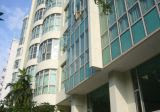For the financial year ended Dec 31, 2009 (FY09), net profit was down 2.47% to RM2.51bil on revenue of RM9.71bil, which was 7.47% lower than FY08 after taking into consideration a one-off goodwill income of RM200mil in respect of the bancassurance distribution alliance with ING Asia/Pacific Ltd.
Excluding the one-off income, the bank’s underlying operating pre-tax profit improved by 4.5% for FY09 compared with FY08.
According to analysts, the bank’s net profit was above market expectations. The market had projected a net profit of RM2.41bil but net profit for FY09 came in 4.14% higher.
Earnings per share (EPS) for FY09 stood at 73.3 sen with the EPS for the quarter under review at 19.7 sen, representing a quarter-on-quarter uptrend with net return on equity at 26.1%. The bank also declared a second interim cash dividend of 25 sen less 25% tax and a share dividend to be distributed from treasury shares on the basis of one share for every 68 existing shares held.
OSK Research Sdn Bhd analyst Keith Wee said in a report that restraint in future dividend payout and concerns over the need for additional capital and hence more subdued returns on equity growth would likely cap share price performance in the immediate to medium term.
He said the bank’s management had indicated that future dividend payout ratios could be at a more realistic 50% to 55% (versus the 79.3% payout in FY09) due to the lean core equity capital and potential increase in new regulatory requirements under Basel III.
According to chairman Tan Sri Teh Hong Piow, whose note on the financial results was read by managing director Tan Sri Tay Ah Lek at a media briefing yesterday, the bank’s improved profit was attributable to continued strong growth in net interest and financing income, up10.2% to RM4.71bil.
Teh said this was despite the negative impact on net interest margins arising from the reduction in the overnight policy rate on three occasions between November 2008 and February 2009.
He added that loans grew by 14.4% to RM137.6bil supported by domestic loans and advances, which expanded strongly by 16.8% driven mainly by residential property, passenger car and commercial financing to small medium enterprises (SMEs), making up 78% of the loan portfolio as at the end of 2009.
Teh said domestic loan approvals and loan applications for the year advanced 21.9% and 26.3% respectively compared with FY08. “Housing loan approvals were particularly strong, recording an increase of 39.3% in 2009,” he said.
Meanwhile, Tay said there were no immediate plans to acquire any banks despite the current spate of news on mergers and acquisitions in the local banking scene.
“We plan to open new branches in 2010, with two more in Hong Kong, one in Shenzhen, five in Cambodia, two in Vietnam and one in Laos,” he said, adding that overseas operations contributed 7.2% to pre-tax profit last year.
Tay said there were plans to increase overseas contributions to 15% over a three- to five-year period. “Overall, the bank is targeting loans growth and advances of 14% to 15% or RM20bil for 2010 with contributions from residential property, passenger car and SME financing remaining the main sources of growth,” he said.
Tay said net interest margins were expected to remain stable due to a stable interest rate environment, steady demand for loans and ample liquidity in the system. “We expect the overnight policy rate to remain low as inflation is low and there is a need to support the economic recovery,” he said.



No comments:
Post a Comment